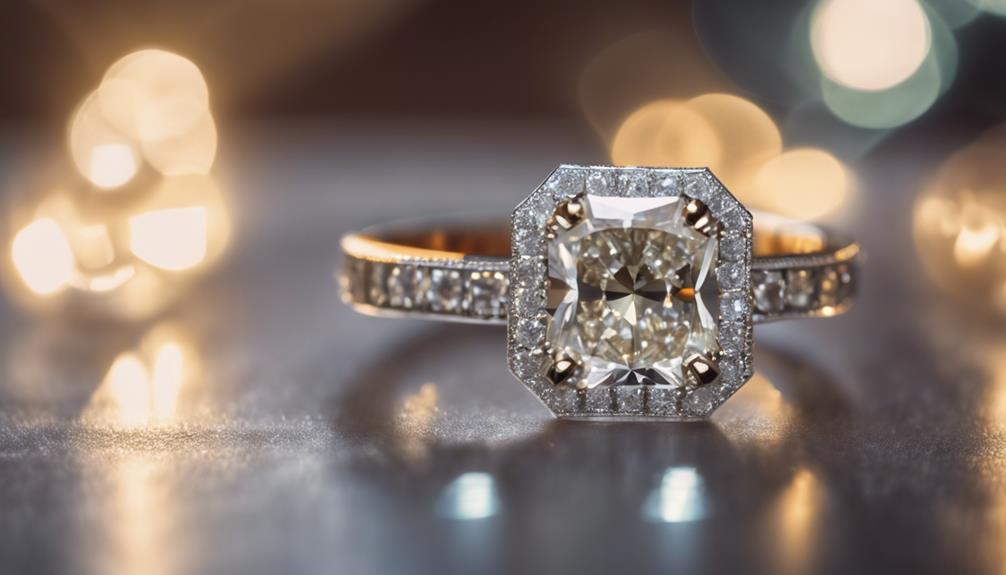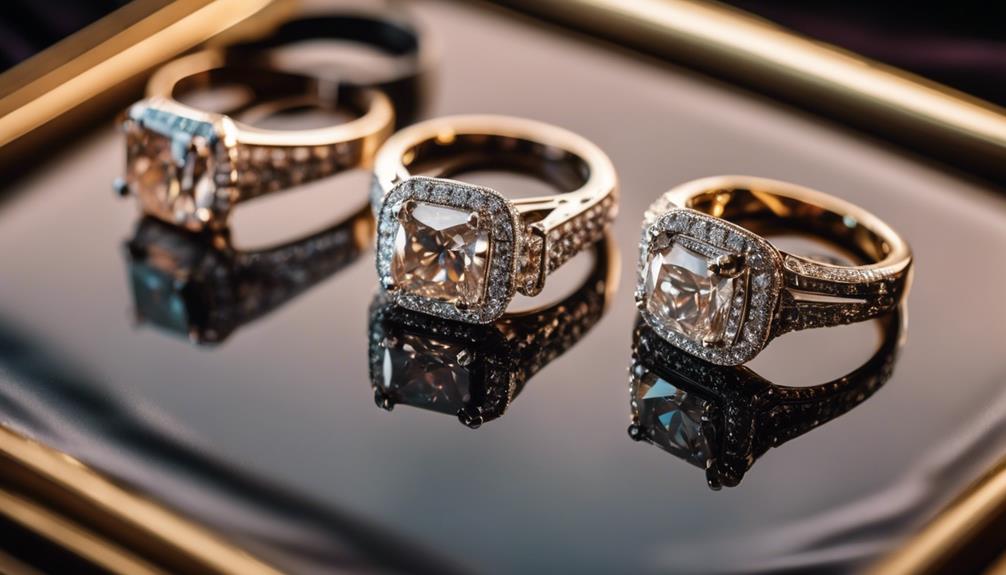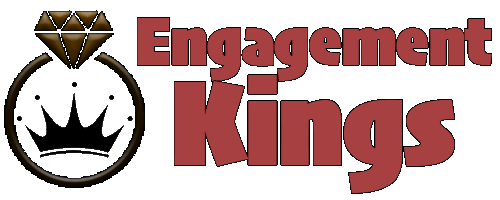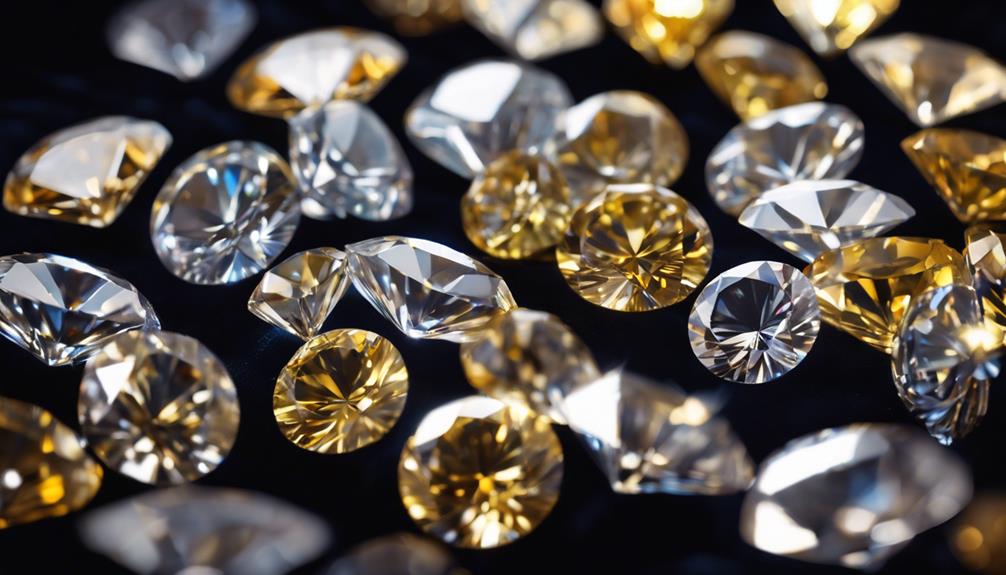J color diamonds offer a great mix of affordability and near colorless charm. They have a faint yellow hue that’s usually hard to notice, especially in yellow or rose gold settings, which can make them look whiter. These diamonds are about 20% cheaper than I color diamonds and around 35% less than H color diamonds, giving you more bang for your buck. They’re an excellent choice for budget-conscious buyers who want a timeless look without breaking the bank. Selecting the right cut and setting can really enhance their appearance. Discover how to make the most of your J color diamond purchase!
What Are J Color Diamonds

J color diamonds, sitting at the end of the near colorless range on the GIA’s D-Z grading scale, offer a subtle hint of yellow that’s often unnoticeable to the casual observer. These diamonds are classified as near colorless, meaning they exhibit only a faint yellow hue. From a top view, most people perceive them as white, especially in smaller sizes or well-cut stones. The faint yellow hue is more noticeable from the side or in larger diamonds, but even then, it remains subtle.
You’ll find that the cut quality of J color diamonds plays a significant role in their perceived whiteness. A well-cut diamond maximizes brilliance and sparkle, which can mask any slight color tint. This makes them an attractive option for those looking for beauty without the higher price tag of more colorless diamonds.
When setting J color diamonds, yellow or rose gold settings can enhance their appearance. These warmer metals complement the faint yellow hue, making the diamond appear whiter by reducing the visibility of any color tint.
Fundamentally, J color diamonds offer a perfect blend of affordability and aesthetic appeal, especially when paired with the right setting.
J Color Diamond Pricing
When considering diamond purchases, you’ll find J color diamonds offer substantial savings compared to higher color grades. These diamonds are a cost-effective choice without compromising much on visual appeal. Let’s break down the key aspects of J color diamond pricing to help you understand why they offer better value.
- Significant Savings: J color diamonds are priced approximately 20% lower than I color diamonds and 35% lower than H color diamonds.
- Lower Popularity: Their lower popularity contributes to their price differences, making them a savvy choice for budget-conscious buyers.
- Comparison with Higher Grades: A 1-carat J color diamond averages around $3,080, whereas a G color diamond costs about $4,990. This translates to substantial savings of nearly $2,000.
- Larger Stones for the Same Budget: Because they’re more affordable, you can often purchase larger stones or better overall quality within the same budget compared to higher color grades.
Price differences between J and D color diamonds can exceed $3,000, highlighting the substantial savings. J color diamonds offer better value, enabling you to maximize your budget. So, if you’re looking for a high-quality diamond without breaking the bank, J color diamonds are a fantastic option.
Best Settings for J Color Diamonds

To enhance the beauty of J color diamonds, consider settings in yellow or rose gold that complement their natural warmth. These gold tones can make the slight color in J color diamonds less noticeable, blending the diamond’s hue with the setting itself. A yellow gold setting, in particular, provides a harmonious backdrop, letting the diamond shine without drawing attention to its color.
Alternatively, choosing platinum or white gold settings can effectively minimize the visibility of any yellow tint. These cooler metals create a striking contrast against the diamond, making it appear whiter and brighter. This is especially effective when the diamond is a round brilliant cut, as this cut maximizes brilliance and sparkle, masking any color when viewed from above.
When selecting a setting style, it’s best to avoid pavé or halo settings for J color diamonds, as these can accentuate the diamond’s color. Instead, opt for simpler settings like a four-prong or bezel style. These settings can obscure some of the diamond’s body color, allowing the stone to appear more colorless.
Comparing J Color to Other Grades
Many buyers often wonder how J color diamonds stack up against higher-grade diamonds like G, H, or I. J color diamonds fall at the end of the near colorless range on the GIA scale, showing a subtle warmth compared to higher grades. Here’s a closer look at the distinctions:
- Visual Difference: The visual difference between J color diamonds and those graded G or H is often minimal. To the naked eye, especially when viewed from above, you mightn’t detect any noticeable color variation.
- Price: J color diamonds can be nearly 30% cheaper than I color diamonds, offering substantial savings. This makes them an attractive option for budget-conscious buyers who still want a near colorless diamond.
- Larger Diamonds: For diamonds over 1.5 carats, color becomes more apparent. Higher color grades like G, H, or I might be recommended for larger stones to guarantee the best appearance.
- Comparison to K Color: While J color diamonds are preferred for their near colorless status, K color diamonds offer even more savings. However, many buyers still favor J due to its higher position on the GIA scale.
Ultimately, J color diamonds provide a balance between aesthetic appeal and cost, making them a great choice for many.
Buying Tips for J Color Diamonds

Choosing a J color diamond involves prioritizing factors like cut quality and setting to maximize its visual appeal and value.
First, focus on cut quality; an ideal or excellent cut can greatly enhance a diamond’s brilliance, making any subtle yellow tint less noticeable.
Next, think about the setting. Opt for yellow or rose gold settings to complement the warmth of J color diamonds. These metals harmonize with the diamond’s hue, creating a cohesive look. Conversely, platinum or white gold settings can minimize the perception of color by providing a contrasting backdrop.
When it comes to clarity grade, aim for a VS1 or VS2 rating. These grades guarantee minimal visible inclusions, enhancing the overall beauty of the diamond without compromising its sparkle.
Don’t overlook the importance of diamond shape. Round brilliant cuts are excellent at concealing color, making them a popular choice for J color diamonds. However, step cuts like emerald or Asscher might reveal more tint due to their larger, open facets.
Lastly, compare diamonds side-by-side to see how they differ in color. Without direct comparison to higher grades, the subtle color of a J diamond may be less noticeable, helping you make an informed decision.
Conclusion
To sum up, J color diamonds offer a remarkable blend of visual appeal and value.
Don’t let the faint hints of yellow deter you; with the right cut and setting, these diamonds can truly sparkle.
Remember, understanding grading standards and how color perception works will empower you to make an informed choice.
Whether you’re new to diamond buying or a seasoned collector, exploring J color diamonds can lead you to some stunning possibilities.
Happy diamond hunting!



